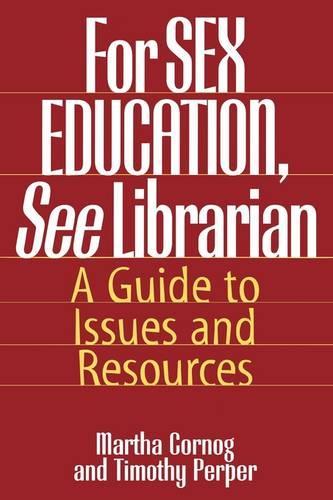
For SEX EDUCATION, See Librarian: A Guide to Issues and Resources
(Hardback)
Publishing Details
For SEX EDUCATION, See Librarian: A Guide to Issues and Resources
By (Author) Martha Cornog
By (author) Timothy Perper
Bloomsbury Publishing PLC
Greenwood Press
28th August 1996
United States
Classifications
Professional and Scholarly
Non Fiction
Gender studies, gender groups
Archiving, preservation and digitization
Sex and sexuality: advice, topics and issues
Ethical issues: censorship / freedom of expression
306.7
Physical Properties
Hardback
432
Description
At long last, here is the definitive practical guide to sexuality materials in libraries and an annotated bibliography of nearly 600 recommended books for school and public libraries. Cornog and Perper, the preeminent experts on sexuality materials for libraries, provide guidelines for materials selection, reference, processing, access, programming, and dealing with problems of vandalism and censorship. The bibliography, organized into 5 topics and 48 subtopics, annotates a collection of recommended books and nonprint materials on sexuality information for children and adults, most published since 1985. Recommended works represent a wide variety of views, including Christian and conservative. Part I offers detailed guidance for selecting and processing sexuality materials, including vertical files, audiovisuals, and periodicals, and for doing reference on sexuality topics; lists a full range of topics and viewpoints that libraries should collect; addresses a variety of processing and access issues such as cataloging, programming, and vandalism; discusses how to deal with censorship issues relating to sexuality materials in the library; and reviews the history of libraries and sexuality materials. Part II, the annotated bibliography, is organized into 5 broad topicssexuality and behavior, homosexuality and gender issues, life cycle issues, sex and society, and sexual problemswhich are then divided into 48 subtopics. Each title is compared and contrasted with similar titles. Titles for young people include grade level appropriateness. Specialized acquisition sources are also listed for each of the 48 subtopics. Cornog and Perper point out that the key to selection of materials is balance and representativeness of a wide range of viewpoints. They have gone to great lengths to provide a wide variety of materials and viewpoints and to seek out interesting and valuable materials from large and small publishers and organizations. This is the definitive guide on sexuality information for public and school libraries.
Reviews
Part 1 concentrates on the theoretical and practical aspects of sexuality materials in the library (e.g., selection, access, and censorship). Part 2 has 48 topical sections (e.g., Life Cycle Issues, Sexual Problems, Sex and Society). Each topical section has a well-written introductory narrative and annotated bibliography. Part 2 is the more impressive, showing devotion to detail and including representative viewpoints. . . . Highly recommended for school libraries and general readers. * Choice *
Still mindful of educating librarians on the need for sexuality collections, [Cornog and Perper] begin their book by discussing the role of the library in supporting community sex education programs. The authors also furnish practical information on organizing and accessing the diverse materials available in various subject areas and genres. They address censorship issues, giving advice on how to deal with complaints and challenges. . . . [T]his guide to sexuality materials is an indispensable resource for building collections in this complex and sensitive subject area. * ^X^BLibrary Journal^R *
Reading the book constitutes a thorough course in materials published about sex and the philosophy behind their selection. A chapter called 'Lfe Cycle Issues' is helpful in evaluating the elements of sexuality in materials for youth. . . . [I]t is an excellent choice for a district or regional library. . . . This accessibly written book provides an enriched background. Recommended. * ^X^BThe Book Report^R *
Let me start by saying that every librarianschool, public, academic, regardless of age-groups servedshould read and use this important and unique contribution to the professional literature. Those who use the book solely for the annotated resource lists in the second part will miss the point and value of this work, which lie in the chapters exploring the history of libraries in sex education, selection and evaluation of materials, access, censorship, building a balanced collection, and, most important, exploring the reasons it is incumbent upon librarians, wherever they work and whatever their personal viewpoint, to purchase a wide range of materials for their patrons. . . . The treatment is comprehensive and evenhanded, and the straightforward, non-academic writing style, which is laced with humor, is a breath of fresh air. * ^X^BVOYA^R *
[I]t does offer the most intelligent, rational, and straightforward analysis and discussion of some critical issues that is available. . . . [A]n excellent source of information about the best available sexuality materials. * Journal of Information Ethics *
Author Bio
Martha Cornog, MA, MLS, edited Libraries, Erotica, & Pornography (1991), which won the American Library Association's Eli M. Obeler Award for Intellectual Freedom in 1992. With her husband, Timothy Perper, she has written articles on sexuality materials in the library for Library Journal, Collection Building, Journal of Information Ethics, and SIECUS Report. She has also published on sexual language and communication and contributed to The Complete Dictionary of Sexology (1995) andIHuman Sexuality: An Encyclopedia (1994). She and Timothy Perper are currently preparing a work on Sex and Religion in Modern America. She has been active in the Society for the Scientific Study of Sex and served on the editorial board of The Journal of Sex Research. She is manager of membership services for the American College of Physicians. Timothy Perper, PhD,is the author of Sex Signals: The Biology of Love (1985) and co-editor of A Descriptive Dictionary and Atlas of Sexology (Greenwood, 1991). He has published on human as well as animal sexuality, contributing to Human Sexuality: An Encyclopedia (1994) and authored or co-authored three chapters in Libraries, Erotica, & Pornography (1991), edited by his wife, Martha Cornog. An independent writer, researcher, and lecturer, he is active in the Society for the Scientific Study of Sex and a former book review editor of The Journal of Sex Research.
